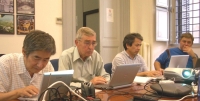Director's Corner
19 July 2007
 Barry Barish |
Project Managers join the GDE Executive Committee
The new GDE Project Managers met face to face with the GDE Executive Committee (EC) for the first time in Rome on 9 and 10 July. As of this meeting, they are part of the EC. Made up of senior members of the GDE, the EC gives me advice on important policy issues and planning. It also shares the responsibility for all major decisions of the GDE. The EC had a very important central guiding role during the reference design, and will continue as the highest-level committee during the engineering design phase that will lead to an Engineering Design Report in about 2010. In a very unusual arrangement, the three Project Managers are now officially members of the EC for all matters outside of EDR project management and at the same time will be reviewed by the EC for the progress of their own work.
Prior to our new members, the EC consisted of three senior accelerator scientists, Nick Walker (DESY), Tor Raubenheimer (SLAC) and Kaoru Yokoya (KEK), and three regional directors, Brian Foster (Europe), Mike Harrison (Americas) and Mitsuaki Nozaki (Asia). In the newly reconstituted EC, Marc Ross (Fermilab) and Akira Yamamoto (KEK) are new members and Nick Walker now plays a new role. For the two-day face-to-face meeting EC meeting in Rome, Ewan Paterson participated in place of Tor Raubenheimer. The meeting was held at INFN Headquarters, thanks to Roberto Petronzio, in the two days just before a meeting of the Funding Agencies for Large Colliders (FALC).
 EC at work: Kaoru Yokoya, Ewan Paterson, Akira Yamamoto and Nick Walker |
 EC at work: Mike Harrison, Maxine Hronek and Marc Ross |
Our meeting included two half days dedicated to reviewing the plans of the new Project Manager troika. They presented to us a mandate for the EDR phase that included the following:
- Basic R&D to demonstrate that all components can be engineered.
- R&D into alternative solutions to mitigate remaining risk.
- An overall design to allow machine construction to start within three years,
- Selection between high-tech options must be made to allow industrialisation efforts.
- A comprehensive value engineering exercise must be conducted.
- A complete value cost estimate for the machine must be provided, including a funding profile consistent with the project schedule.
- A project execution plan must be produced, including a realistic schedule.
- Designs for facilities shared between different “area systems”, and for site-specific infrastructure. The designs must include the level of detail needed for regions to estimate the cost to host.
- All necessary information must be provided to regions to evaluate project technical and financial risks in support of a bid to host.
This three-year engineering design programme will result in an Engineering Design Report that can then serve as the basis of funding proposals to governments.
We dedicated the other half of the EC meeting to a broad range of ILC/GDE business that included planning for future GDE meetings and publishing the RDR and companion document for presentation to the ILCSC and ICFA during the Lepton-Photon 2008 Conference in August in Korea. We also went over preparations and requests for FALC.
During the past two years, I have relied very much on the EC to advise me on the very broad range of issues, both technical or otherwise, that have enabled us to accomplish our goals thus far. This EC worked very hard and very well together during this period, building trust, putting aside local interests, and trying their best to serve the needs and goals of the GDE and the ILC. I fully expect the reconstituted EC, now having the vital representation of the Project Management team, to fill much the same roll over the coming few years.
-- Barry Barish